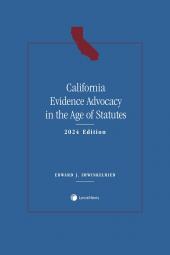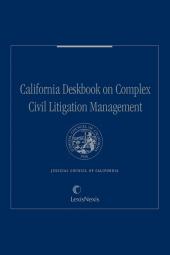California Evidence Advocacy in the Age of Statutes
Select a format
 International Order Inquiry
International Order Inquiry
Select subscription type
Terms & conditions
Subscribers receive the product(s) listed on the Order Form and any Updates made available during the annual subscription period. Shipping and handling fees are not included in the annual price.
Subscribers are advised of the number of Updates that were made to the particular publication the prior year. The number of Updates may vary due to developments in the law and other publishing issues, but subscribers may use this as a rough estimate of future shipments. Subscribers may call Customer Support at 800-833-9844 for additional information.
Subscribers may cancel this subscription by: calling Customer Support at 800-833-9844; emailing customer.support@lexisnexis.com; or returning the invoice marked "CANCEL".
If subscribers cancel within 30 days after the product is ordered or received and return the product at their expense, then they will receive a full credit of the price for the annual subscription.
If subscribers cancel between 31 and 60 days after the invoice date and return the product at their expense, then they will receive a 5/6th credit of the price for the annual subscription. No credit will be given for cancellations more than 60 days after the invoice date. To receive any credit, subscriber must return all product(s) shipped during the year at their expense within the applicable cancellation period listed above.
The total price includes the product(s) listed in the Order Form and any Updates for a limited period (minimum period of 30 days) after the order is placed ("Order Window"). Shipping and handling fees are not included in the grand total price.
All shipments may be returned, at subscribers' expense, for full credit of the Price within 30 days of receipt.
Shipments may not be returned, and no credits will be issued, more than 30 days after receipt.
After the Order Window, subscribers will receive notice of Updates along with the then-current grand total price and order process as Updates become available. Subscribers will only be shipped those Updates they specifically request.
Product description
View a sample of this title using the ReadNow feature
California Evidence Advocacy in the Age of Statutes helps attorneys and other legal professionals develop an advocacy style suited for the “Age of Statutes.” The text attempts to do so in three ways:
First, every chapter of the text cites the relevant Code section by number and uses bolding to highlight the crucial language in each statute. Hopefully, it will become second nature to both cite and quote. The intent is to raise the reader’s consciousness of the precise wording of the Code sections.
Second, Appendix A is designed to help the reader find the Code sections relevant to his or her evidentiary issue. In some respects, the Code is poorly organized; it does not deal with evidentiary issues in the sequence in which litigators normally think of them. Chapter 2 presents a simple, logical sequence for analyzing evidentiary issues. Appendix A repeats the sequence and annotates it by citing the Evidence Code sections most relevant to each step in the sequence. The organization of this text reinforces that sequence; the chapters cover the evidentiary doctrines in the very same order as they are listed in Appendix A.
Thirdly and most importantly, Appendix B is designed to help the litigator preparing a filing or making an oral argument quickly find the specific relevant Evidence Code section and the key language. Using the terminology employed in Chapters 3-31, Appendix B lists evidentiary doctrines in alphabetical order. In some cases, Appendix B double lists the doctrines to make it even easier to find the governing statute.
Reading California Evidence Advocacy in the Age of Statutes in its entirety will make the reader more conscious of and sensitive to the exact wording of C.E.C. provisions.
Whenever possible, point the judge directly to the word, phrase, clause, or sentence that should dictate that the judge rule in your favor on the evidentiary point.
eBooks, CDs, downloadable content, and software purchases are noncancelable, nonrefundable and nonreturnable. Click here for more information about LexisNexis eBooks. The eBook versions of this title may feature links to Lexis+® for further legal research options. A valid subscription to Lexis+® is required to access this content.
Table of contents
Chapter 1 The First Takeaway: A Textualist Mindset for Construing the California Evidence Code
Chapter 2 The Second Takeaway: An Understanding of the Simple Structure of the Evidence Law Codified in the C.E.C.
I. PROCEDURE
Chapter 3 Related Procedures
II. ADMISSIBILITY
The Competency of Prospective Witnesses
Chapter 4 The General Requirements
Chapter 5 Special Status Rules
Logical Relevance
Chapter 6 Facial and Underlying Logical Relevance
Chapter 7 Authentication
Chapter 8 The Validation of a Scientific Methodology
Chapter 9 Rules Limiting the Admissibility of Logically Relevant Evidence
Legal Irrelevance Exclusionary Rules Targeting the Trier of Fact
Chapter 10 The Trial Judge’s General Authority Under California Evidence Code Section 352
Chapter 11 Character, Habit, and Other Acts Evidence Offered on the Historical Merits
Chapter 12 Credibility Evidence
Exclusionary Rules Targeting the Witness
------Hearsay
Chapter 13 The Definition of Hearsay
Chapter 14 The Admission Exception to the Hearsay Rule
Chapter 15 Documentary Hearsay Exceptions That Do Not Require a Showing of the Declarant’s Unavailability
Chapter 16 Nondocumentary Hearsay Exceptions That Do Not Require a Showing of the Declarant’s Unavailability
Chapter 17 Hearsay Exceptions That Require a Showing of the Declarant’s Unavailability
Chapter 18 Miscellaneous Hearsay Exceptions Useful in Civil Estate, Family, and Property Litigation
Chapter 19 Miscellaneous Hearsay Exceptions Useful in Criminal Cases
Chapter 20 A Residual Hearsay Exception
-----Opinion Evidence
Chapter 21 Lay Opinion Testimony
Chapter 22 Expert Opinion Testimony
-----Best Evidence
Chapter 23 The Secondary Evidence Act Exclusionary Rules Targeting Out-of-Court Actors
Chapter 24 A General Overview of Communications Privileges
Chapter 25 Important Aspects of the Most Frequently Encountered Communications Privileges
Chapter 26 Government Privileges
Chapter 27 Topical Privileges for Political Votes and Trade Secrets
Chapter 28 Quasi-Privilege Rules That Are Based in Part on Extrinsic Social Policy
III. SUFFICIENCY
Chapter 29 The Formal Presentation of Evidence by a Party: The Initial Burden of Production or Going Forward and the Legal Sufficiency of the Evidence
Chapter 30 The Formal Presentation of Evidence by a Party: The Ultimate Burden of Proof and the Factual Sufficiency of the Evidence
Chapter 31 Judicial Notice and Stipulations Between the Parties
Chapter 32 Conclusion
Appendix A
Appendix B
Index
 Lexis Nexis
Lexis Nexis 

